Flushing the gas boiler heat exchanger: cleaning methods and means for removing mineral deposits
Hot water in the faucet and stable +23 ° C in the house, when there is severe frost outside the window - is not it true that these benefits of civilization have become familiar? Now answer a simple question: was the gas boiler heat exchanger flushed after the previous heating season? If your answer is “no,” you risk being left without heat in the winter.
To avoid this, read our article on the fight against scale and on the prevention of the accumulation of mineral deposits. We have set out in detail tried-and-tested methods for dealing with calcium plaque, which reduces the efficiency of the unit and increases fuel consumption. Our tips will help increase heat dissipation and extend the life of the boiler.
The content of the article:
- How is scale formed and what is dangerous
- Soot on exterior surfaces
- How often do you need to flush the heat exchanger
- Methods for removing contaminants
- Chemicals for cleaning and prevention
- Design features of heat exchangers
- How to descale a plate heat exchanger
- Shell-and-tube heat exchanger flushing
- Features of flushing coaxial heat exchangers
- Floor boiler cleaning and flushing
- Conclusions and useful video on the topic
How is scale formed and what is dangerous
Not a single liquid can be compared with ordinary water in specific heat. Depending on temperature and pressure, this indicator varies in the range from 4174 to 4220 Joules / (kg · deg). Water is non-toxic, affordable and cheap, making it an almost perfect heat transfer medium.
And yet at H2About there is a significant drawback - in its natural state it contains salts of alkaline earth metals Ca and Mg. When heated, they form insoluble carbonate, or, otherwise, calcareous deposits on the inner surfaces of the heat exchange equipment.
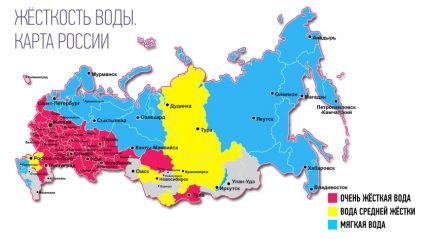
The negative effects of scale formation are as follows:
- efficiency decreases;
- water pressure decreases;
- boiler wear accelerates;
- increased costs.
Domestic heating boilers and water heaters are mainly equipped with surface heat exchangers, in which heat is transmitted through the surface of the metal walls.But the scale has a high thermal resistance, that is, low thermal conductivity.
For this reason, the heat transfer coefficient decreases in contaminated heat exchangers, which leads to a decrease in temperature. coolant in the heating circuit and insufficient heating of the water at the outlet of the hot water circuit.

Hard deposits with a thickness of only 0.2 mm increase fuel consumption by 3%. If the scale thickness is 1 mm, the gas overrun will reach 7%.
With a decrease in heat transfer, more gas is required to maintain a given water temperature, which indicates a decrease in efficiency. At the same time, with increasing fuel consumption, the volumes of flue gases increase, the emission of harmful substances polluting the air around the household and the atmosphere as a whole increases.
Deposits completely or partially overlap the pipe bore, which leads to an increase in hydraulic resistance in the system, disruption of the coolant circulation, and a decrease in the supply of hot water at the points of water intake.

Violation of heat transfer leads to overheating of the pipes, which causes the formation of microcracks - future foci of corrosion. Due to operation at extreme conditions, the unit prematurely fails.
To prevent equipment breakdown, descaling must be periodically removed. Routine cleaning of heat exchangers gas wall boilers and floor units are carried out within the time period established by the manufacturer. A simple procedure helps to maintain energy efficiency of the equipment at the initial level, prolongs the overhaul period, reduces the total cost of operation.
Soot on exterior surfaces
With incomplete combustion of gas, soot settles on the outer surfaces of the heat exchanger — an amorphous carbon allotrope. Heat exchangers of boilers with an open combustion chamber and natural draft suffer from soot more.
One of the reasons for its increased formation is the dustiness of the air in the room, from where combustion air comes from. A lot of dust is emitted during construction work. If the construction site is near the entrance of the coaxial chimney, the boiler heat exchanger with a closed chamber may become contaminated.
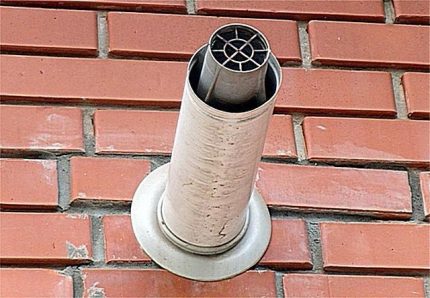
Insufficient diameter, incorrect configuration, chimney blockages lead to poor traction. With poor traction, the removal of combustion products is difficult, and they are deposited in the form of soot on the lower outer part of the heat exchanger.
Like limescale, soot has low thermal conductivity and reduces the efficiency of heat exchange equipment, leads to its accelerated wear, and reduces the overhaul period. The efficiency of a heat exchanger contaminated with soot and scale can decrease by 25% or more.
How often do you need to flush the heat exchanger
The frequency of cleaning is indicated by the equipment manufacturer in the operating instructions. For example, heat exchangers in Neva boilers must be descaled every 12 months.
The concentration of alkaline earth salts in water can be different. If the concentration is high, water is called hard. When using it, scale forms faster, therefore, unscheduled cleaning may be required. Also, the rate of formation of deposits depends on the thermal regime and the intensity of the boiler.
The presence of scale in the pipes of the heat exchanger and soot on its fins is signaled by a decrease in the heat output of the equipment.To determine whether the actual heat output is as stated in the documentation, measure the temperature and composition of the flue gases using a gas analyzer.
In the absence of the device, the presence of scale can be judged by indirect signs: a decrease in temperature and water pressure at the outlet of the boiler. If the water pipe is normal water pressure, and a thin stream runs from the tap, check for deposits on the inner surfaces of the heat exchanger tubes.
Inadequate heating of the water at standard gas flow rate and normal pressure also indicates contamination of the heat exchanger.
Note that malfunctions in the operation of complex equipment can be caused by various reasons and the presence of scale is only one of the options.
Methods for removing contaminants
To remove scale and soot, mechanical, hydraulic, chemical and other methods or combinations thereof are used.
Mechanical cleaning heat exchange equipment is performed using a ramrod, wire brush, scraper. Both hand tools and electric or pneumatic actuators are used.
Application hydraulic method It is possible only with a high-pressure apparatus, which will provide a powerful fluid flow that can bring down deposits and bring them out.
Chemical way provides for the use of special products that loosen and dissolve contaminants.
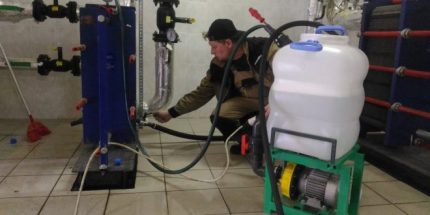
Magnetic, electromagnetic, ultrasonic methods are relatively new and include the use of filter converters and other technical means.
A combination of mechanical and chemical methods is most often used to clean the heat exchangers of domestic water heaters and heating boilers. After soaking (pickling) in the detergent, the remaining scale is mechanically cleaned. Also gaining popularity are the modern techniques mentioned above.
Chemicals for cleaning and prevention
Descaling agents contain organic or inorganic acids. In the production of household products, adipic and phosphoric acids are most often used. At home, prepare aqueous solutions of citric or acetic acid.
Acids are reagents - they are able to react with alkaline earth salts and form other water-soluble salts, which are then removed from the heat exchange equipment.
Alkalis are also used, for example, soda ash or caustic soda, which allows loosening carbonate deposits and soot, facilitating subsequent mechanical and chemical cleaning. Alkaline solutions are also used to neutralize traces of acid left in the heat exchanger after descaling.
Most reagents are supplied to customers in the form of highly concentrated aqueous solutions and require additional dilution with water in certain proportions specified in the instructions for use.
It is necessary to follow the manufacturer's instructions for the preparation of the working solution and not exceed the concentration of the product. Otherwise, contact of the materials of the heat exchange equipment with an aggressive substance will lead to acceleration of corrosion.
When choosing tools take into account the material of manufacture of the heat exchanger. Usually it is copper, stainless steel or cast iron. For instance, Aminate D Designed for stainless steel and carbon steel heat exchangers. Another reagent in the same series. Aminate D (K) used for cleaning copper surfaces.
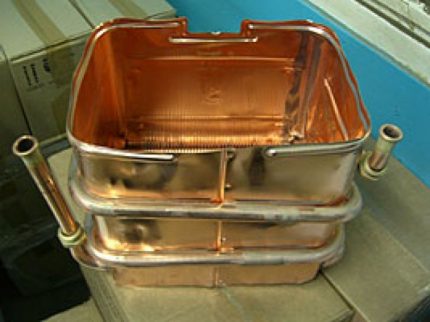
Universal remedies include citric acid, vinegar, Medesk Plus, Trilon B. They are used to flush non-ferrous metal and stainless steel heat exchangers.
Trilon B Is a disodium salt of ethylenediaminetetraacetic acid. It has the appearance of a white crystalline powder. When Trilon B interacts with alkaline earth salts (scale), calcium and magnesium ions are replaced by sodium ions. As a result, sodium salts are formed, which dissolve well in water.
Funds having a complex composite composition are produced. They simultaneously contain components that cleanse the scale and prevent its formation.
Composite CCF differs from other chemicals in the principle of action. It is not a solvent like acids, but in its presence self-cleaning of carbonate deposits (scale) occurs.
Under normal conditions, calcium carbonate crystals form in the form of petrified mineral plaque. This is the scum. In the presence of CCF, instead of mineral plaque, another modification of calcium carbonate is formed - aragonite.
Needle crystals of aragonite during growth destroy calcium deposits. In contrast, aragonite has poor adhesion to the surface of the heat exchanger and is therefore easily removed by washing with ordinary water.
The active substances of CCF already at the initial stage impede the formation of calcite crystals. As a result, scale formation is significantly slowed down or completely suppressed. This process is called inhibition (translated from Latin: “delay”).
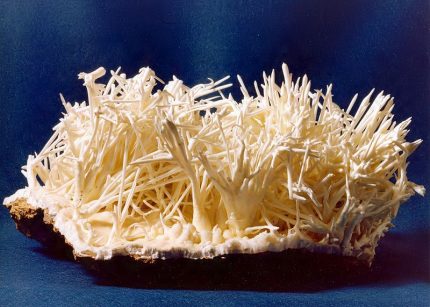
CCF inhibits not only scale, but also corrosion due to the formation of a protective film on the metal surface. When buying anti-scale products, do not forget to clarify whether they have certificates of Rospotrebnadzor.
Design features of heat exchangers
To properly flush the heat exchanger, you need to know its design. You will find all information about your boiler in the instruction manual.
Just in case, we recall that for the organization of autonomous heating and hot water supply in apartments and private houses, gas boilers and water heaters with heat exchangers of the following types:
- shell and tube;
- coaxial;
- lamellar.
In widespread shell-and-tube heat exchangers, water circulates through a pipe that, in the form of a coil, wraps around the side walls of the casing. Such an assembly is soldered or welded, that is, non-separable.

Plate-type heat exchangers are less common. Their main constructive part is a metal bag in which several plates are assembled.
For example, heat exchangers Westen zilmet and Baxi include from 10 to 16 plates. They give their heat to the water moving between them through the channels. Such a device must be disassembled before cleaning.
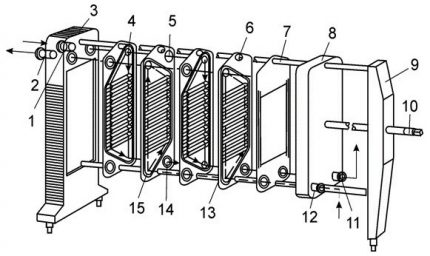
The main element of a coaxial (bithermic) heat exchanger is two coaxial pipes. In the simplest version, it looks like a spiral with tightly fitting turns.
For double-circuit boilers, the presence of 2-3 heat exchangers is characteristic.For example, the NEVALUX-8023 boiler is equipped with three heat exchangers, one of which is coaxial, but not of a spiral type, but with series-connected links.
How to descale a plate heat exchanger
Turn off the boiler, turn off the gas and water supply, drain the water from the heat exchanger and wait until it cools down. Disconnect the piping, unscrew the tie rods, move the pressure plate under which the plates are located.
Carefully separate them from each other. Remove each plate separately so as not to get hurt on sharp edges, work in tight protective gloves. When working with acid, change them to rubber.
Prepare a container in which you will soak the plates, taking into account that they must be completely immersed in the liquid.
Use the cleaning agent in accordance with the attached instructions. Table vinegar is diluted with water in a ratio of 1 to 3. Powdered citric acid - in a ratio of 1 to 10. Water for the solution is preheated to 40 ° C. The plates are immersed in the solution for 1 hour, after which the remaining deposits are removed with a brush under running water.
After dismantling and cleaning, place the plates in a horizontal position so that they lie on a table or other work surface.

When disassembling the heat exchanger, at the same time inspect the gaskets and sealing elements and, if damaged, replace them with new ones. It is recommended to change all gaskets at once, even if only one of them is worn. Assemble all elements in the reverse order of disassembly. Replace the heat exchanger.
Shell-and-tube heat exchanger flushing
Turn off the boiler, turn off the taps on the inlet pipes to save water in the heating system. Drain the heat exchanger. Disconnect wires from the thermal relay and disconnect the hot water pipes. Loosen the nuts and screws that secure the heat exchanger, remove it.
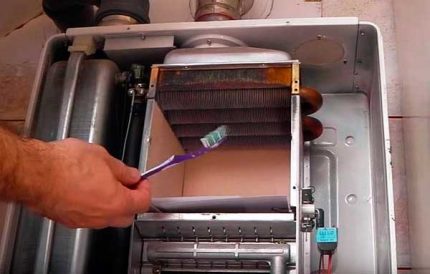
To flush the shell-and-tube heat exchanger from a thick layer of carbonate deposits, it must be removed from the housing. The dismantling process does not require special skills
Visually inspect surfaces. If there is soot on the fins or in other areas, immerse the heat exchanger in a detergent containing alkali. It can be a solution of ordinary laundry soap.
Unless otherwise specified in the instructions, soaking should last about 15 minutes. Then brush off the soot. Rinse the heat exchanger under running water with good pressure.
To remove scale, place the heat exchanger in a basin or other container. Pour citric acid solution (10% concentration) into the pipe. After 12-15 hours, flush the pipes with clean water. Also flush or replace the filters for the domestic hot water circuit.
Replace the heat exchanger. After cleaning, it is also advisable to replace all gaskets. If rubber gaskets, use silicone to lubricate them.
Next, the heat exchanger must be checked for leaks. A saturated soap solution is applied to the detachable connections of the gas circuit. In the presence of leaks, bubbles form in the washed areas.
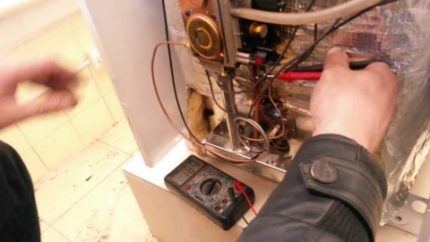
When checking the water circuit in double-circuit gas boiler separately turn on the heating and hot water supply system and inspect each plug-in connection. If a leak is detected, tighten the nut or install a new seal.
Features of flushing coaxial heat exchangers
Often the pipes of the bithermic heat exchanger are made of different metals. The outer pipe may be steel, and the inner copper. Therefore, for washing, you need to use a universal tool that is poured into the pipes, the necessary time is maintained and merges. The heat exchanger is washed and returned to its place.
Floor boiler cleaning and flushing
Descaling and soot removal is carried out without dismantling the heat exchanger. A flushing pump (booster) is used. An aqueous solution of citric acid is poured into its container. For 2 liters of warm water, 200 grams of citric acid powder is required.
Before cleaning floor gas boiler, turn off the gas and water supply taps, drain the water from the heating and domestic hot water circuit. Next, you need to get to the heat exchanger. Remove the door, disconnect the wires connected to the piezoelectric element, remove the thermocouple and nozzle, dismantle the ignition system and burner.
Loosen the nuts securing the top cover and remove it. You have gained access to the heat exchanger and you can clean it of soot with a brush and a brush.
Connect the booster leads to the heat exchanger pipes, which, under pressure, inject a solution of citric acid into the pipe. By circulating the contour for 4-6 hours, it dissolves scale. Flushing time depends on the level of contamination.
Use a pH meter to keep the process under control. This device will show the change in the concentration of acid in the solution, which occurs as a result of the ongoing chemical reaction of the dissolution of carbonate deposits.
If the acid has neutralized and pH 1 is displayed on the instrument, you may need to repeat the process from the beginning. A stable pH of 2 to 4 indicates descaling.
At the end, the pipes are washed with a solution of baking soda to neutralize the residual traces of the reagent. Then it remains to install the parts in place, check the unit for leaks by washing and visual inspection of detachable joints, or by crimping. In the absence of gas and water leaks, the boiler is operated as usual.
Conclusions and useful video on the topic
The gas boiler heat exchanger can be easily washed at home without the use of professional equipment:
How to clean the secondary heat exchanger of a double-circuit boiler from scale and what is needed for this:
Modern methods and tools help to effectively combat scale and prevent its formation. The main thing is not to forget to periodically flush the heat exchanger so that the real characteristics of the gas boiler correspond to the passport indicators throughout the entire life cycle.
Tell us about how you washed the heat exchanger of your own gas boiler. Share the effective plaque removal methods known to you. Please leave comments in the form below the block, ask questions and publish photos on the topic of the article.

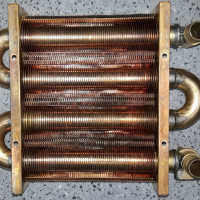 Do-it-yourself gas boiler heat exchanger repair + instruction on repair and part replacement
Do-it-yourself gas boiler heat exchanger repair + instruction on repair and part replacement 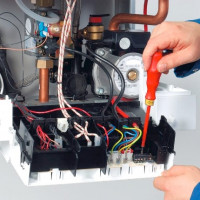 Repair of a gas boiler "Proterm": typical malfunctions and error correction methods
Repair of a gas boiler "Proterm": typical malfunctions and error correction methods  Repair of a gas boiler Vaillant: decoding of encoded irregularities in work and methods of dealing with problems
Repair of a gas boiler Vaillant: decoding of encoded irregularities in work and methods of dealing with problems 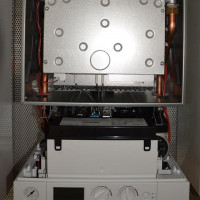 Error codes for a gas boiler Viessmann: methods for troubleshooting and recovery
Error codes for a gas boiler Viessmann: methods for troubleshooting and recovery  Conord gas boiler malfunctions: common breakdowns and solutions
Conord gas boiler malfunctions: common breakdowns and solutions 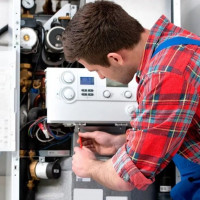 How to increase the efficiency of a gas boiler with your own hands: the best ways to increase the efficiency of the boiler
How to increase the efficiency of a gas boiler with your own hands: the best ways to increase the efficiency of the boiler  How much does it cost to connect gas to a private house: the price of organizing gas supply
How much does it cost to connect gas to a private house: the price of organizing gas supply  The best washing machines with dryer: model rating and customer tips
The best washing machines with dryer: model rating and customer tips  What is the color temperature of light and the nuances of choosing the temperature of the lamps to suit your needs
What is the color temperature of light and the nuances of choosing the temperature of the lamps to suit your needs  Replacement of a geyser in an apartment: replacement paperwork + basic norms and requirements
Replacement of a geyser in an apartment: replacement paperwork + basic norms and requirements